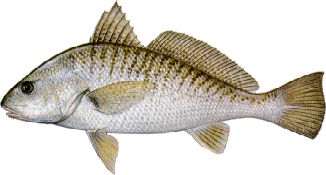
Micropogonias undulatus
Croaker, Hardhead
Atlantic Croakers are silvery overall, with a faint pinkish-bronze cast. The back and upper sides are grayish, with brassy or brown spots that form oblique wavy lines on the fish’s sides. Several characteristics separate this species from its close relatives. They are 3 to 5 pairs of small chin barbels, a strongly serrated preopercular margin with 3 to 5 spines at its angle and 64 to 72 scales along the lateral line. The Croaker has a convex tail.
Croakers feed chiefly on animals and detritus that occur on the bottom, as evidenced by their inferior mouths and chin barbels. Schools of Atlantic Croaker search the flats and bars for food on an incoming tide and feed on crustaceans, worms, mollusks, de
Along the coast from Cape Cod to Texas, south to Yucatan, Mexico, not common north of New Jersey or in South Florida.
The Atlantic Croaker prefers a sand or shell bottom. It's a regular catch in many surf areas but also can be caught from sloughs and channels of inside waters, particularly those with soft bottom.
Atlantic Croakers average a pound or less, but sometimes reaches 3 pounds, or perhaps slightly more.
5 pounds, 8 ounces (IGFA)